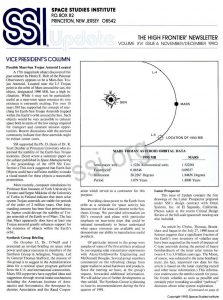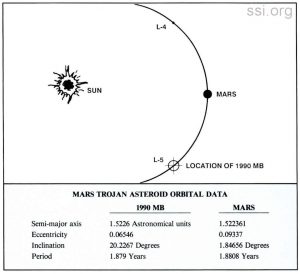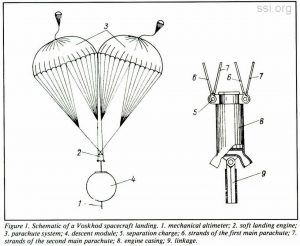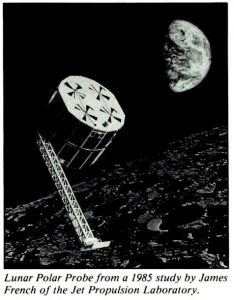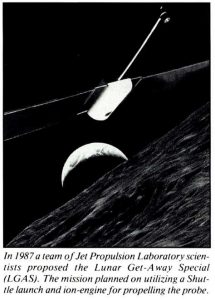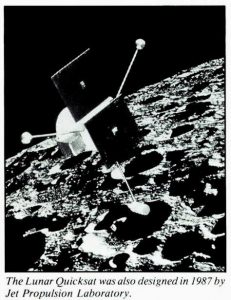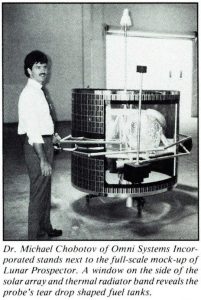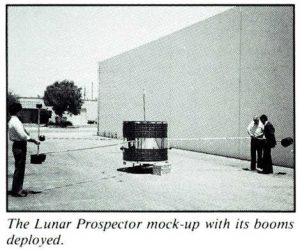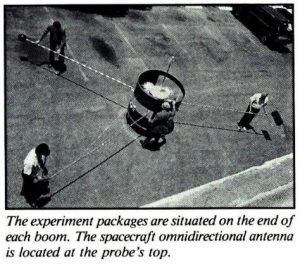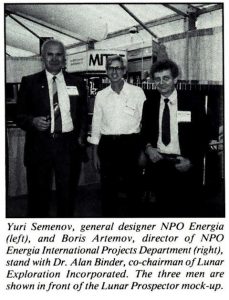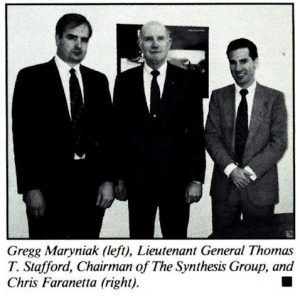SPACE STUDIES INSTITUTE
P.O. BOX 82
PRINCETON, NEW JERSEY 08542
[[librarian note: This address is here, as it was in the original printed newsletter, for historical reasons. It is no longer the physical address of SSI. For contributions, please see this page]]
SSI UPDATE
THE HIGH FRONTIER® NEWSLETTER
VOLUME XVI ISSUE 6 NOVEMBER/DECEMBER 1990
VICE PRESIDENT’S COLUMN
Possible Mars-Sun Trojan Asteroid Located
A 17th magnitude object discovered this past summer by Henry E. Holt of the Palomar Observatory appears to be a Mars-Sun Trojan Asteroid. Located near the L5 Trojan point in the orbit of Mars around the sun, the object, designated 1990 MB, has a high inclination. While it may not be particularly useful as a near-term space resource its very existence is extremely exciting. For over 10 years SSI has supported the concept of searching for Earth-Sun Trojan Asteroids trapped within the Earth’s orbit around the Sun. Such objects would be very accessible to cislunar space both in terms of the low energy required for transport and constant mission opportunities. Recent discussions with the asteroid community indicate that these asteroids might be extinct comet cores.
SSI supported the Ph.D. thesis of Dr. R. Scott Dunbar at Princeton University who examined the stability of the Earth-Sun Trojan locations. (Scott wrote a summary paper on the subject published in Space Manufacturing 3, the proceedings of the 1979 SSI Conference.) This work suggested that Earth-Sun Objects could have sufficient stability to make a visual search for these objects a reasonable proposition.
More recently, computer simulations by Professor Kim Innanen of York University in Toronto and Seppo Mikkola of the University of Turku in Finland indicate that inner solar system Trojan asteroids are stable for periods of the order of 2 million years. One longstanding concern has been that perturbations by Jupiter could disrupt the stability of Trojan asteroids of the Earth or of Mars. The fact that Mars apparently does have at least one Trojan asteroid greatly enhances support for the existence of objects within the Earth’s orbit.
Synthesis Group Briefing
On October 15, Dr. O’Neill and presented an invited briefing on space solar power and space resources to members of the Synthesis Group in Arlington, Virginia. Led by General Thomas Stafford, the mission of this group is to suggest to the Administration ideas for a rational space program gathered from the U.S. and international communities. Many SSI supporters have supplied ideas and suggestions through several intake mechanisms including the American Institute of Aeronautics and Astronatuics, the Aerospace Industries Association and the Rand Corporation which served as a contractor for this purpose.
Providing clean power to the Earth from orbit as a rationale for space activity has become one of the areas of interest to the Synthesis Group. We provided information on SSI’s research and plans with particular emphasis on near-term steps that could be initiated immediately to better understand what space resources are available and to demonstrate our ability to manufacture useful products.
Of particular interest to the group were samples of some of the first artifacts produced by our ongoing solar concentrator experiments with Alcoa/Goldsworthy Engineering and McDonnell Douglas. Several group members commented on the refreshing change from paper studies to actual hardware and products. Since the meeting we have, at the group’s request, forwarded additional information. We will advise you of further developments as they unfold. The Synthesis Group is planning to issue its recommendations during the first quarter of 1991.
Lunar Prospector
This issue of Update contains the first drawings of the Lunar Prospector prepared under SSI’s design contract with Omni Systems, Inc. of El Segundo, California. Photos taken at the recent Critical Design Review of the full-scale spacecraft mockup are also included.
An article by Chyba, Thomas, Brookshaw and Sagan in the July 27, 1990 issue of Science suggests that a significant fraction of the Earth’s own inventory of volatiles may have been acquired as the result of impacts of C-type asteroids during the period of heavy bombardment of the inner solar system between 4.5 to 3.8 billion years ago. The Moon, of course, was subjected to the same bombardment. (In fact, important raw data for this article is based on the lunar cratering record and other lunar information.) This information underscores the need to search for possible frozen volatiles as soon as possible and certainly prior to making so-called “pathway” decisions about solar system exploration.
Also, I’m pleased to report that NASA and SSI have now signed the final agreement for SSI’s use of the Apollo gamma-ray spectrometer for the Lunar Prospector Program.
Lunar Glass Pilot Progress
Several important milestones have been achieved in our Lunar Glass Pilot Plant project described in the last issue of Update. The Alcoa Technical Center has fabricated and shipped a second test crucible for the project. A 9:1 Platinum/Rhodium liner for the crucible has been prepared by Alcoa/Goldsworthy Engineering. MLS-1 lunar simulant procured by SSI through the University of Minnesota, is now being utilized in addition to the basaltic simulant supplied by Professor Leonard Bernold of the University of Maryland.
In addition to work leading to the use of the facility for the production of glass fibers and matrix material for composites, experiments are underway in the manufacture of glass bricks and other cast materials for lunar construction. Local and national news sources have “discovered” this project and it is receiving quite favorable consideration from the media and the technical community.
New Gift Membership Program
Writing this column during the month of October the realization is just beginning to sink in that 1990 will soon be over and the holidays upon us before we know. We are pleased to announce a special SSI gift membership program which includes a one year membership in the Institute, a year’s subscription to the SSI Update and a copy of Dr. Gerard K. O’Neill’s award winning book, The High Frontier, all for $30.00. Give the gift of a hopeful future and introduce a friend to the crucial work that we share! Call us at xxx-xxx-xxxx during East Coast business hours or Fax your order at xxx-xxx-xxxx. VISA and Mastercard are accepted.
Thanks for your continued support of the Institute’s work during 1990. Best wishes from all of us here at SSI!
Gregg Maryniak
INSTITUTE ACQUIRES SOVIET TECHNICAL STUDIES OF MANNED SPACECRAFT
As part of our ongoing discussions with representatives of the Soviet space program, SSI has entered into a series of agreements enabling us to publish Soviet technical documents in the West.
We have been successful in obtaining first-rate technical translations ofthe first set of these documents and are now in a position to make the first of these available to the public. Our initial offering is a treatise entitled Manned Spacecraft by V.N. Bobkov and Vladimir S. Syromyatnikov. This 64-page document provides a review of all U.S. and Soviet manned space vehiclesfrom Gagarin ‘s orbital flight aboard Vostok in 1961, through the development of the U.S. Space Shuttle.
Space educators will be particularly interested in the level of technical detail given with respect to both Soviet and U.S. systems. In particular, data on the propulsion systems and attitude control systems is quite difficult to come by for early U.S. space systems but is present in this work. Line drawing illustrations (some of which have not reproduced particularly well) are provided and show several novel approaches taken in designing such things as the first soft landing system for the return of three cosmonauts to the surface of the Earth. (See excerpt.)
The serious space enthusiast or educator will find this a valuable addition to his or her working library. Copies of the report are available for $35.00 postpaid through the Institute.
Multi-Occupant Spacecraft are Launched
Excerpt from Manned Spacecraft by V.N. Boskov and Vladimir S. Syromyatnikov
As already noted, the capabilities of the Vostok booster rocket and the equipment in the Vostok spacecraft made it possible to make new steps in the direct conquest of space by humans. In 1963-1964 two models of the Voskhod spacecraft were created, one for the simultaneous flight of three cosmonauts, and one for the first entry of a human into open space.
The multi-occupant Voskhod spacecraft required a significant change in the approach to the arrangement of cosmonauts in the spacecraft and provisioning of descent to Earth. In particular it was necessary to reconfigure the cosmonaut cabin and introduce new landing equipment.
Three seats were placed in the spacecraft cabin, and the cosmonauts sat in these seats without space suits. To ease the overloads in the active portion of the flight and on landing, the seats were individually designed to the size and shape of each cosmonaut. To decrease overloads on landing the seat was also supplied with additional shock absorbers.
A number of innovations and improvements were introduced into various spacecraft systems. In orbital space flight. The Voskhod was the first to have so-called ion sensors which make it possible to measure the angle of deviation of the longitudinal axis of the spacecraft relative to the velocity vector of flight in orbit. At an altitude of several hundred kilometers the Earth’s atmosphere contains a large number of positively charged ions, and their natural (thermal) velocity is substantially less than the velocity of the spacecraft.
If one places the receiving tubes of the sensors in a certain way to capture the flux of ions, one can measure the angle of deviation from the symmetrical position of the tubes relative to the impinging flux of ions, that is, to the velocity vector of flight. It must be said that ion sensors were used for the first time on the Voskhod.
In the multi-occupant version of the spacecraft it was impossible to provide for emergency increase in the length of flight due to a failure of the braking engine assembly. Thus, the Voskhod (in the upper portion) has an additional solid-fuel braking engine assembly.
Cosmonauts V.M. Komarov, K.P. Feoktistov, and B.B. Yegorov completed a one-day flight program on October 13, 1964, landing in the cabin of the descent module. In order to reduce overloads on impact with the Earth, the descent of the module was made on two parachutes, and just before contact with Earth, a signal from the landing sensor actuated a solid-fuel engine attached to the strands of the parachutes (Figure 1). This was the first soft landing of a descent module on Earth.
In order to go out into open space, it was necessary to introduce significant changes in the structure of the spacecraft cabin. Primarily, an airlock was introduced, which on launch was placed in a folded position in the descent module and was deployed by inflation after the spacecraft was placed in orbit. On Voskhod two cosmonauts, P.I. Belyayev and A.A. Leonov, were in space suits.
The space suit for leaving the spacecraft differed substantially from the hermetic suit used in case of depressurization of the spacecraft. When work is done outside the craft, much more heat is given off and more oxygen is required. The thermal fluxes are much more intense. The hermetic suit itself must be much more durable, and the entire structure of the suit is substantially more reliable since outside of the craft it alone protects the cosmonaut from vacuum, overheating, overcooling, and other types of radiation. Finally, all of the cosmonaut’s means of life support, or part of them, should be in the suit itself.
The space suit created by Soviet specialists went successfully into open space. The space walk was made by A.A. Leonov on March 18, 1965. This suit for the first walk of a human in open space was the prototype for future designs developed later to carry out longer and more complex work in open space.
After completion of the flight program, P.I. Belyayev manually oriented the spacecraft and landed in a back-up landing region. The search and recovery of a cosmonaut in the taiga in winter was not an easy task. The operation was completed successfully, which confirmed the technical decisions made and the organizational measures which were taken.
With this the program of manned multioccupant Voskhod flights concluded. The results demonstrated the great capabilities of the equipment and uncovered new prospects for the conquest of space.
LUNAR PROSPECTOR UPDATE
Chronology of the Lunar Prospector Concept
1985
Jim French of JPL performs Lunar Prospector study under contract to SSI.
Gregg Maryniak briefs National Commission on Space on results of French study.
1986
National Commission on Space report (Pioneering the Space Frontier, Bantam Books, NY 1986) recommends a robotic lunar orbiting lunar prospector stating: “It is a first priority to search the permanently shadowed craters near the lunar poles, where ices containing carbon, nitrogen and hydrogen may be found.”
1987
SSI initiates dialogue with JPL teams proposing “Lunar Getaway Special” and “Lunar Quicksat” missions for lunar polar orbiters.
SSI Senior Associate Ron Jones prepares high resolution graphics supporting simple lunar orbiter missions which the Institute supplies to JPL.
Gerard O’Neill and Gregg Maryniak provide two briefings to NASA Administrator Dr. James Fletcher on lunar prospector concepts. Dr. Fletcher requests briefing on Lunar Quicksat from JPL.
1988
SSI initiates discussions with members of Congress on Lunar Prospector and the possibility of using surplus NASA equipment.
Dr. Gay Canough initiates discussions with potential science investigators on SSI’s behalf.
1989
Lunar Prospector Workshop conducted in Princeton. Participants include Dr. Alan Binder and Preston Carter of Houston, Texas, who go on to found Lunar Exploration Inc. to organize support for Prospector within the Johnson Space Center community.
Using results from the Princeton LP Workshop, Houston team drafts the Request for Proposals for a design study of the Lunar Prospector Spacecraft. SSI issues the RFP.
International Space University examines a lunar polar orbiting mission as a Design Project under the guidance of Jim Burke and Gay Canough.
Omni Systems Incorporated of El Segundo, California is selected as the Lunar Prospector design contractor.
Members of Congress request NASA support of Lunar Prospector via use of Apollo surplus gamma-ray spectrometer.
Admiral Richard Truly agrees in principal to supply gamma-ray spectrometer and appoints Dr. Joseph K. Alexander, Assistant Associate Administrator for Space Science and Applications as SSI’s liaison to NASA for this project.
1990
SSI contract executed with Omni Systems regarding design phase.
Preliminary Design Review of Lunar Prospector Design conducted in El Segundo.
Initial meetings conducted with representatives of NPO Energia in Princeton regarding possibility of Lunar Prospector launch.
Second Soviet delegation visits Princeton regarding launch possibilities.
Omni Systems initiates construction of full-scale spacecraft mockup.
Space Studies Institute and Lunar Exploration Inc. create Lunar Prospector Consortium.
Omni Systems completes phase B design study of Lunar Prospector Probe.
Critical Design Review conducted at El Segundo.
Chris Faranetta meets with head of NPO Energia in Moscow. NPO Energia provides letter of intent regarding launch.
NASA and SSI sign final agreement regarding use of the Apollo gamma-ray spectrometer.
Yuri Semenoff, head of NPO Energia, visits SSI HQ in Princeton. He then travels to Houston with Chris Faranetta where he views the full-scale mockup at the Space Exploration ’90 Conference.
Lunar Prospector Consortium briefs General Thomas Stafford and the staff of the Synthesis Group on the mission.
Meeting Notice and Call for Papers
10th Biennial Space Studies Institute/Princeton Conference on Space Manufacturing
May 15-18, 1991
General Information:
This Conference is a forum for papers on all aspects of the use of nonterrestrial resources. The program includes papers both on technical aspects of space development and on the social sciences. In order to accommodate a broad range of presentations, three different types of presentations will be encouraged: 1) the traditional presentation of papers in the auditorium at the Woodrow Wilson School, 2) a poster session and display, 3) an evening session on advanced space systems. The first three days of the Conference will be open only to registered participants. A summary session on Saturday, May 18 is free and open to all.
Sessions: External Tanks and Space Structures; Biomedical Considerations; Space Power; International Considerations; Lunar Bases; Space Biospheres; Nonterrestrial Resources; Space Transportation and Space Exploration Initiative; Poster Session; Advanced Space Concepts.
Submission of Abstracts: Abstracts of papers received by January 15, 1991 will be considered for inclusion in this conference. Please limit abstracts to one page with no references. Abstracts and other inquiries should be sent to: Barbara Faughnan, Conference Coordinator, Space Studies Institute, P.O. Box 82, Princeton, NJ 08542.
Registration Fee: $320 covers all sessions with breaks, luncheons, proceedings, and the banquet.
Update articles in progress for 1991 include:
Aluminum Mine in the Sky – A project underway between the Air Force Institute of Technology and the Space Studies Institute is developing systems to recover construction materials from Space Shuttle external tanks.
Lunar Electrolysis – See the latest developments and equipment used in experiments to process lunar soil with electric currents.
By-Products of Lunar Glass Experiments – In addition to glass fibers, our joint project with Alcoa/Goldsworthy Engineering and McDonnell Douglas is using the solar thermal system to make bricks and cast objects for lunar construction.
New Information on the Energia Heavy Lift Booster – Information will include applications for Lunar Base support and fully reusable heavy lift systems.
©space studies institute
NEXT: 1991 January February NASA/DOE Select SSI as SPS Archive

